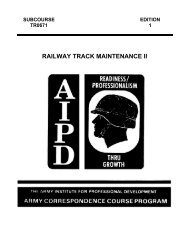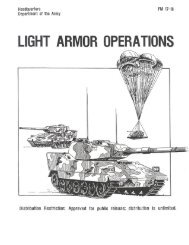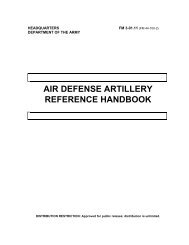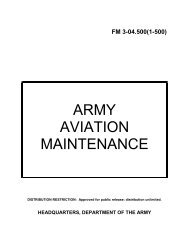fm 44-100 us army air and missile defense operations
fm 44-100 us army air and missile defense operations
fm 44-100 us army air and missile defense operations
Create successful ePaper yourself
Turn your PDF publications into a flip-book with our unique Google optimized e-Paper software.
FM <strong>44</strong>-<strong>100</strong><br />
TACTICAL BALLISTIC MISSILES<br />
2-2. TBMs include short-range ballistic <strong>missile</strong>s (SRBM) with ranges up to<br />
1,000 kilometers <strong>and</strong> medium-range ballistic <strong>missile</strong>s (MRBM) with ranges<br />
from 1,000 to 3,000 kilometers. These are surface-launched <strong>missile</strong>s with<br />
ballistic trajectories. TBMs, often launched from highly mobile, difficult-todetect<br />
transporter erector launchers (TEL), have the capability to carry<br />
WMD. Most TBMs are single-stage <strong>missile</strong>s with a circular error probable<br />
(CEP) accuracy of one-tenth of one percent of their range. State-of-the-art<br />
guidance technologies in some <strong>missile</strong>s will reduce these errors to less than<br />
50 meters. What makes tactical ballistic <strong>missile</strong>s (TBMs) threatening? TBMs<br />
are inherently difficult to defend against. Characteristics that increase TBM<br />
effectiveness include a reduced radar cross section (RCS), high terminal<br />
velocity, reduced notification time for defending forces, a variety of difficultto-kill<br />
warheads, <strong>and</strong> an all-weather capability. The major TBM trends are<br />
increased range <strong>and</strong> improved accuracy.<br />
2-3. Integration of global positioning system (GPS) <strong>and</strong> terminal guidance are<br />
the current foc<strong>us</strong> of improving accuracy. Solid fuels <strong>and</strong> multiple staging will<br />
increase TBM payloads <strong>and</strong> ranges. Improved TBMs may target point<br />
targets. Figure 2-1 ill<strong>us</strong>trates the characteristics of TBMs.<br />
LARGE CALIBER ROCKETS<br />
2-4. Large-caliber rockets (LCR) are similar to SRBM in size, trajectory,<br />
warheads, <strong>and</strong> battlefield targets. The ability of LCR to deliver high volumes<br />
of fire <strong>and</strong> a variety of warheads makes them ideal weapon systems for fire<br />
support missions. Highly mobile launchers effectively support forward<br />
artillery missions. This mobility <strong>and</strong> the rocket’s short burn time result in<br />
little warning for maneuver forces <strong>and</strong> their short-range hamper engagement<br />
by current <strong>missile</strong> <strong>defense</strong> systems.<br />
2-5. Rockets are widely proliferated, <strong>and</strong> their production <strong>and</strong> sale is<br />
increasing. The high volume of fire <strong>and</strong> multiple warhead capabilities of LCR<br />
make them a very appealing weapon system for threat nations. In the future,<br />
threat nations may deploy passive infrared (IR) <strong>and</strong> radio frequency (RF)<br />
2-2<br />
Targets<br />
Current Capabilities<br />
• Geopolitical/population centers • Range from 80 to 3000 Km<br />
• Airports <strong>and</strong> seaports<br />
• Accuracy to within 50 m of target<br />
• Logistical areas<br />
• Low radar signature<br />
• Troop concentrations<br />
• Warheads - conventional, WMD<br />
Future Trends<br />
• Improved accuracy<br />
• improved guidance<br />
• Improved control packages<br />
• Improved terminal guidance<br />
• Increased range<br />
• Increased payload capacity<br />
Figure 2-1. Characteristics of TBMs











